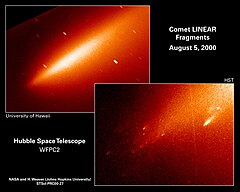C/1999 S4 (LINEAR) was a long-period comet discovered on September 27, 1999, by LINEAR.[1]
 Hubble image of C/1999 S4 disintegrating on August 5, 2000 | |
| Discovery | |
|---|---|
| Discovered by | LINEAR (704)[1] |
| Discovery date | September 27, 1999 |
| Orbital characteristics | |
| Epoch | February 17, 2000 (JD 2451591.5) |
| Aphelion | ~1400 AU[2] (Q) |
| Perihelion | 0.76509 AU (q) |
| Semi-major axis | ~700 AU[2] (a) |
| Eccentricity | 1.00010[3] |
| Orbital period | ~18,700 yr (epoch 2010)[2] |
| Inclination | 149.38° |
| Last perihelion | July 26, 2000[3] |
| Next perihelion | unknown/disintegrated |
The comet made its closest approach to the Earth on July 22, 2000, at a distance of 0.3724 AU (55,710,000 km; 34,620,000 mi).[4] It came to perihelion on July 26, 2000, at a distance of 0.765 AU from the Sun.[3]
The comet nucleus was estimated to be about 0.9 km in diameter.[5] Before the comet broke up, the (dust and water) nucleus erosion rate was about 1 cm per day.[5] The comet brightened near July 5, 2000, and underwent a minor fragmentation event.[6] The comet brightened again around July 20, 2000, and then disintegrated.[7] The published optical and most radio data support that the main nuclear decay started July 23, 2000.[5] The dust cloud expanded at about 20 meters per second (45 miles per hour) while the fragments expanded at around 7 m/s (16 mph).[5] Other comets are known to have disappeared, but Comet LINEAR is the first one to have been caught in the act.[8]
The orbit of a long-period comet is properly obtained when the osculating orbit is computed at an epoch after leaving the planetary region and is calculated with respect to the center of mass of the solar system. Using JPL Horizons, the barycentric orbital elements for epoch 2010-Jan-01 generate a semi-major axis of 700 AU, an aphelion distance of 1400 AU, and a period of approximately 18,700 years.[2]
References
edit- ^ a b "MPEC 1999-T02 : COMET C/1999 S4 (LINEAR)". IAU Minor Planet Center. 1999-10-01. Retrieved 2011-09-01.
- ^ a b c d Horizons output. "Barycentric Osculating Orbital Elements for Comet C/1999 S4 (LINEAR)". Retrieved 2011-09-01. (Solution using the Solar System Barycenter and barycentric coordinates. Select Ephemeris Type:Elements and Center:@0)
- ^ a b c "JPL Small-Body Database Browser: C/1999 S4 (LINEAR)" (last observation: 2000-07-24; arc: 301 days). Jet Propulsion Laboratory. Retrieved 2011-09-01.
- ^ "JPL Close-Approach Data: C/1999 S4 (LINEAR)" (last observation: 2000-07-24; arc: 301 days). Retrieved 2011-09-01.
- ^ a b c d Altenhoff, W. J.; et al. (2002). "Radio continuum observations of Comet C/1999 S4 (LINEAR) before, during, and after break-up of its nucleus". Astronomy & Astrophysics. 391 (1): 353–360. Bibcode:2002A&A...391..353A. doi:10.1051/0004-6361:20020783.
- ^ Donna Weaver, Michael Purdy (July 28, 2000). "Hubble Sees Comet Linear Blow its Top". Hubblesite newscenter. Retrieved 2011-09-04.
- ^ Ray Villard, Michael Purdy (August 7, 2000). "Hubble Discovers Missing Pieces of Comet Linear". Hubblesite newscenter. Retrieved 2011-09-04.
- ^ Mark Kidger (4 August 2000). "COMET LINEAR: GOING, GOING... BUT NOT QUITE GONE!". The Isaac Newton Group of Telescopes. Retrieved 2011-09-01.
External links
edit- Orbital simulation from JPL (Java) / Horizons Ephemeris
- C/1999 S4 ( LINEAR ) – Seiichi Yoshida @ aerith.net
- C/1999 S4 (LINEAR) – Gary W. Kronk
- Hubble Sees Comet Linear Blow its Top STScI-2000-26 (7 July 2000)
- Hubble Discovers Missing Pieces of Comet Linear STScI-2000-27 (5 August 2000)
- The VLT Observes Comet LINEAR's "Shower" (6 August 2000)
- Comet LINEAR continues to disintegrate and could disappear completely within a few days Archived 2020-07-27 at the Wayback Machine (31 July 2000)